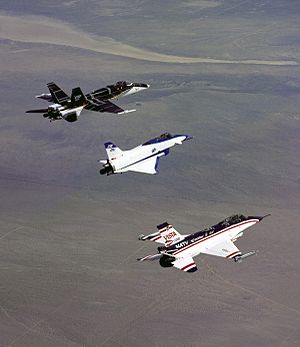| F-16 VISTA | |
|---|---|
| The VISTA/MATV aircraft in formation with the X-31 (middle) and the F/A 18 HARV (top) | |
| Role | Experimental fighter |
| Manufacturer | General Dynamics (later Lockheed Martin) |
| Number built | 1 |
| Developed from | General Dynamics F-16 Fighting Falcon |
The F-16 VISTA testbed aircraft incorporated a multi-axis thrust vectoring (MATV) engine nozzle that provides for more active control of the aircraft in a post-stall situation. The resulting aircraft is supermaneuverable, retaining pitch and yaw control at angles of attack beyond which the traditional control surfaces cannot change attitude.[citation needed]
The VISTA program was considered successful, but the thrust vector control (TVC) never made it into production fighter versions.[citation needed]
The program was also notable for the development of Direct Voice Input and the "Virtual HUD", which were both eventually to be incorporated into the cockpit design for the F-35 Lightning II.[1] The STOVL F-35 variants also incorporate MATV while hovering to provide attitude control.[citation needed]
Contents
|
Specifications
The F-16 VISTA is a Block 30 F-16D based on the airframe design of the Israel Air Force version, which incorporates a dorsal fairing running the length of the fuselage aft of the canopy and a heavyweight landing gear derived from the Block 40 F-16C/D. The fairing houses most of the variable-stability equipment and test instrumentation. The heavyweight gear will permit simulation of aircraft with higher landing sink rates than a standard F-16.- Crew: 2 (one test pilot and one safety pilot)[4]
- Length: 49 ft 5 in (14.8 m)
- Wingspan: 32 ft 8 in (9.8 m)
- Height: 16 ft (4.8 m)
- Wing area: 300 ft² (27.87 m²)
- Airfoil: NACA 64A204 root and tip
- Empty weight: 18,238 lb (8,272 kg)
- Loaded weight: 26,463 lb (12,003 kg)
- Max takeoff weight: 42,300 lb (16,875 kg)
- Powerplant: 1× General Electric F110 afterburning turbofan
- Dry thrust: 14,590 lbf (64.9 kN)
- Thrust with afterburner: 23,770 lbf (105.7 kN)
- Maximum speed:
- At sea level: Mach 1.2 (915 mph, 1,460 km/h)
- At altitude: Mach 2+ (1,500 mph, 2,414 km/h)
- Ferry range: >3,200 mi (2,800 NM, 4,800 km)
- Service ceiling: >50,000 ft (15,239 m)
- Rate of climb: 50,000 ft/min (254 m/s)
- Wing loading: 88.2 lb/ft² (431 kg/m²)
- Thrust/weight: 1.095



No comments:
Post a Comment